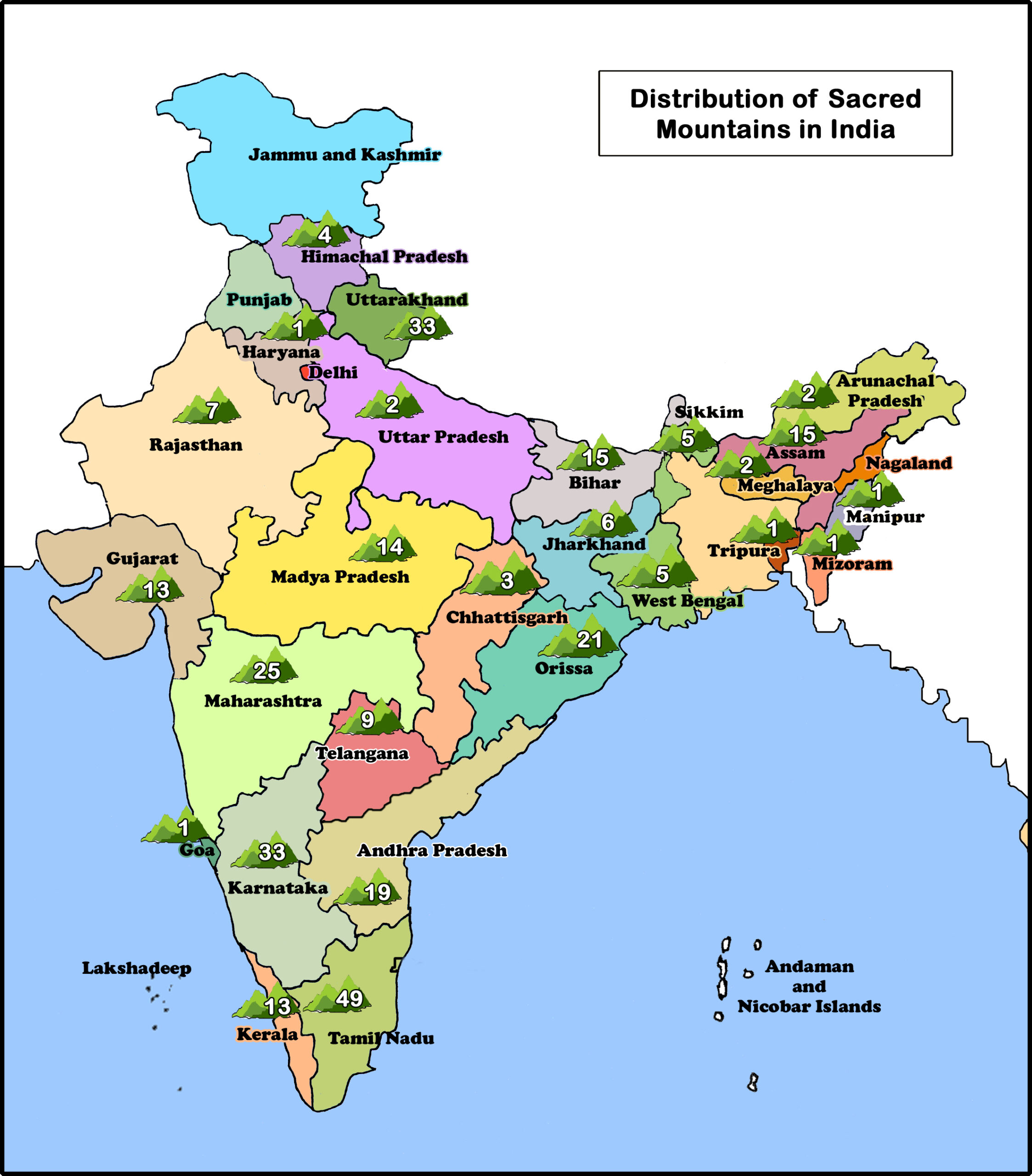
The sacred flame (Karthikai mahadeepam)
atop Mount Arunachala (Tiruvannamalai), Tamilnadu
As one of the most dramatic features of the natural landscape, mountains have an extraordinary power to evoke spirituality and sanctity. The mountains are held sacred for the following reasons:
- Mountains have traditionally been regarded as abodes of Gods. For example, Mount Kailasha (at Tibet) is regarded as the abode of Lord Shiva.
- Some mountains are also held sacred due to their association with deities, mythology or legends. For example, Mount Govardhana at Brindavana is revered for its association with Lord Krishna.
- Mountains are also held revered as places of spiritual attainment.
- Sacred places are a prominent feature of different cultures all over the world. In most cases, it can be shown that the sacredness of a place is linked in some way or the other to natural objects such as trees, groves, gardens, water bodies, caves, landscapes and mountains. These sacred forms and shapes that are derived from natural objects and features often become symbolic or emblematic.
- Throughout the world mountains are revered as mysterious places with the power to evoke an overwhelming sense of the sacred. For people of many different cultures, that mystery and sense of the sacred imbues their existence with meaning and vitality. Regarded as images of the world’s axis, these sacred mountains actually convey multiple ideas of the center of the universe, and as such were and are venerated by all cultures.
- Mount Meru was considered to be the center of all physical and spiritual universes in Hinduism, Buddhist cosmology, and Jain mythology alike. A number of mountains in Asia, such as Mount Kailas in Tibet, and Gunung Agung in Bali, Indonesia, provide the pattern for the mythical Mount Meru or Sumeru, which stands as a cosmic axis around which the universe is organized.
Mountains may be considered sacred in several ways...
- Certain hills and peaks are designated as sacred by particular religious traditions and enveloped with myths, beliefs and religious practices.
- For example, Mount Kailasha (at Tibet) is regarded as the abode of Lord Shiva.
- A mountain may be associated with the activities of holy persons or beings or may contain sacred sites such as temples and groves. For example, Mount Govardhana at Brindavana is revered for its association with Lord Krishna.
- Certain mountains that may not be considered sacred in any traditional sense are revered as places of spiritual attainment. For example Arunachala Mountain at Thiruvannamalai is revered by people and saints as a place for spiritual attainment.
- Throughout the world people look up to mountains as sources of blessings such as water, life, fertility and healing. Hundreds of millions revere the Himalayas, the Abode of Snow, as the source of sacred rivers, such as the Ganges, on whose life-giving waters they depend for their very existence.
Sacred mountains played a vital role in the conservation of local ecology and the environment. A variety of themes are often found within sacred mountain traditions. The beliefs demonstrate an important link between the community’s cultural identity and traditional patterns of land conservation. Sacred mountains are distinguished from other sacred sites as being exceptionally comprehensive ecosystems. Due to their topographic and bio-cultural richness they provide opportunities for climate change adaptation and act as refuges for plants and animals from environmental change and from competing species. They provide opportunities for species to move up and down and to adapt to climate change, which can play a vital role in a species’ survival.
Sacred Mountains and sacred sites within mountains have resulted in communities maintaining and preserving their natural resources in often-pristine conditions. Indigenous communities have long realized the value of the high diversity and natural resources within mountains and that mountain are resources of nature which nurture. The sacred mountain protected due to cultural beliefs has resulted in precious water, timber, flora, fauna, and other natural resources being maintained and preserved for future generations.
Sacred mountains have a special value that makes them worth protecting at all costs. Beliefs and attitudes held by people who revere them can function as powerful forces helping to preserve the integrity of natural environments.
Ideas and beliefs associated with sacred sites in mountains can also be used to help promote conservation, restore damaged environments and strengthen indigenous cultures. Indian scientists have been working with Hindu priests at the major pilgrimage shrine of Badrinath in the Indian Himalayas to encourage pilgrims to plant seedlings for reasons connected to their religious and cultural traditions. They hold planting ceremonies that allow people to enrich their pilgrimage experience by restoring an ancient sacred forest.
Sacred mountains highlight values and ideals that profoundly influence how people view and treat each other and the world around them. In order to be sustainable over the long term, environmental policies and programmes need to take such values and ideals into account; otherwise, they will fail to enlist the local and popular support that they need to succeed.
Source:
Sacred Mountains in India



